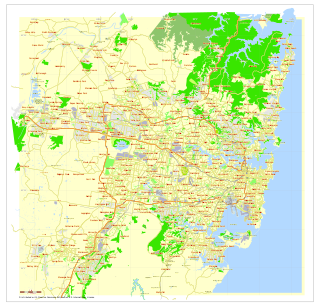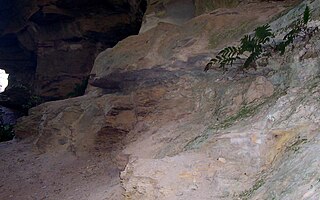| St Michaels Cave | |
|---|---|
 | |
| Location | Avalon Beach, New South Wales, Australia |
| Coordinates | 33°37′44.83″S151°20′21.23″E / 33.6291194°S 151.3392306°E |
| Depth | 15 metres |
| Length | 110 metres |
| Geology | Dolerite & Narrabeen Group |
| Hazards | falling rocks |
| Access | not allowed |
| Coordinates | 33°37′45″S151°20′21″E / 33.62912°S 151.33923°E Coordinates: 33°37′45″S151°20′21″E / 33.62912°S 151.33923°E |
|---|---|
| Managing authorities | |
St Michaels Cave is situated in the Sydney suburb of Avalon Beach. This sea-side cave is around 110 metres long, 15 metres high and 10 metres wide. The original colonial owner was a Reverend John Therry, who planned to deliver lectures within the cave and build a church above it. The cave was formed by the erosion of a jurassic dyke through triassic sedimentary rocks. The cave is known to be a breeding site for Common bent-wing bats and Large-eared pied bats. [1] [2] [3] [4] [5] [6]

Sydney is the state capital of New South Wales and the most populous city in Australia and Oceania. Located on Australia's east coast, the metropolis surrounds Port Jackson and extends about 70 km (43.5 mi) on its periphery towards the Blue Mountains to the west, Hawkesbury to the north, the Royal National Park to the south and Macarthur to the south-west. Sydney is made up of 658 suburbs, 40 local government areas and 15 contiguous regions. Residents of the city are known as "Sydneysiders". As of June 2017, Sydney's estimated metropolitan population was 5,131,326, and is home to approximately 65% of the state's population.
The Jurassic was a geologic period and system that spanned 56 million years from the end of the Triassic Period 201.3 million years ago (Mya) to the beginning of the Cretaceous Period 145 Mya. The Jurassic constitutes the middle period of the Mesozoic Era, also known as the Age of Reptiles. The start of the period was marked by the major Triassic–Jurassic extinction event. Two other extinction events occurred during the period: the Pliensbachian-Toarcian extinction in the Early Jurassic, and the Tithonian event at the end; however, neither event ranks among the "Big Five" mass extinctions.

A dike or dyke, in geological usage, is a sheet of rock that is formed in a fracture in a pre-existing rock body. Dikes can be either magmatic or sedimentary in origin. Magmatic dikes form when magma flows into a crack then solidifies as a sheet intrusion, either cutting across layers of rock or through a contiguous mass of rock. Clastic dikes are formed when sediment fills a pre-existing crack.















